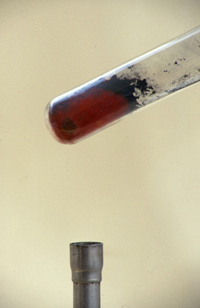|
Chemguide: Core Chemistry 14 - 16 Reactions between metals and metal oxides This page shows how you can build up a part of the reactivity series using reactions between metals and the oxides of other metals. It assumes that you will already have read the page about burning metals and have seen the list of the reactivity series on this page. Why react metals with metal oxides? If you have read the introductory page about burning metals, you will know that you can't safely say anything precise about their reactivity just by heating them in air or oxygen. Too much depends on whether the metal is in a big chunk or a fine powder, or whether there is anything on the surface which prevents oxygen from getting at it. Instead, we put metals in competition with each other over control of oxygen by giving one of the metals oxygen to start with, and seeing if another metal can grab it for itself. The reaction between magnesium and copper(II) oxide This is one of the classic examples. Start by watching this very, very short bit of YouTube video showing what happens when you heat a mixture of magnesium and copper (II) oxide on a piece of ceramic paper on a tripod. There is clearly a very vigorous reaction as the magnesium takes the oxygen from the copper. The equation for the reaction is
Unfortunately, the reaction is so violent, that it is impossible to see easily that any copper metal has been formed. In fact, because of the temperatures created, any that is formed is going to react with oxygen in the air to go back to copper(II) oxide again. But the vigour of the reaction shows that magnesium is definitely higher in the reactivity series than copper. The reaction between aluminium and iron(III) oxide This competition between aluminium and iron again shows that the aluminium is the more reactive metal and takes the oxygen from the iron(III) oxide to leave metallic iron.
I am going to give you two pieces of video about this reaction - one in the lab, and one showing an industrial use for the reaction. Do not try this reaction at home! It can go badly wrong, and put you at serious risk. You will find the term "exothermic" used - an exothermic reaction is one which gives out heat. The first piece of YouTube video shows the reaction in a lecture theatre. Annoyingly it doesn't show the iron formed glowing red in the sand. This second piece of video shows the use of the reaction in welding railway track together. The reaction between carbon and copper(II) oxide Carbon powder and copper(II) oxide are both black. If you heat a mixture in a test tube, a red glow runs through the mixture showing that heat is being produced in the reaction in addition ot the heat from the Bunsen. The mixture turns brown as copper is formed. The photo shows what the tube looks like after the experiment.
The carbon dioxide escapes from the tube as a gas. The reaction shows that carbon is more reactive than copper, because it has taken the oxygen from the copper. The reason that carbon is included in the reactivity series is that it can be used to extract several metals from their oxide ores. It isn't actually used industrially to extract copper from copper ores, but is used to extract iron from iron oxide ores. Carbon is above iron in the reactivity series, and will take oxygen from iron oxide. You will meet that process later in the course. The reaction between magnesium and carbon dioxide This excellent bit of video from the Royal Society of Chemistry shows that although you can use carbon dioxide to put out a petrol (gasoline) fire, you can't do the same thing with a magnesium fire. The magnesium is more reactive than carbon and reacts with carbon dioxide, taking the oxygen from it.
The Reactivity Series Repeating the series from a previous page:
You will see that we have so far shown that
This is not the only way of building up the table, and you will come across other ways over the next few pages. Making predictions from the reactivity series Will zinc react with copper(II) oxide? Yes - zinc is above copper in the reactivity series and so will take the oxygen from the copper. You would get zinc oxide and copper formed. Will silver react with aluminium oxide? No - aluminium is a long way above silver in the reactivity series and so the silver isn't strong enough to take the oxygen from it. Will copper react with hydrogen oxide (water - H2O)? No - copper is below hydrogen in the reactivity series and so copper isn't strong enough to take the oxygen from it. Will potassium react with water? Yes - violently! Potassium is far more reactive than hydrogen, and will certainly take the oxygen from it.
© Jim Clark 2020 |
|||||||||||||||||||||||||||||||||||||||||||
